Episode 215
What you’ll learn in this episode:
- How studying and apprenticing abroad helped Ilona push the limits of her work
- How objects carry memories, and why that can influence someone’s desire to buy a vintage piece
- Why the most important thing a gallerist can do is choose pieces that resonate with them
- How art jewelry galleries create a channel of communication from artist to wearer to observer
- Why jewelry artists have more freedom that other types of artists
About Ilona Schwippel
Ilona Schwippel has run the gallery Viceversa, in Lausanne, Switzerland, with her husband Christian Balmer for 20 years. She holds a bachelor in product design, jewelry and accessories from the High School of Arts and Design (HEAD) in Geneva and a diploma in luxury creations and artistic crafts from the University of Geneva. Since 2017, Ilona has lectured at the University of Applied Science, in Lucerne, in the XS Schmuck department.
Additional Resources:
Photos:
Jewelry by: ANNETTE EHINGER
![]()
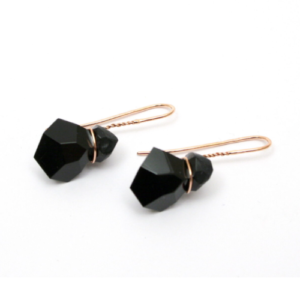
Jewelry by: SOPHIE BOUDUBAN
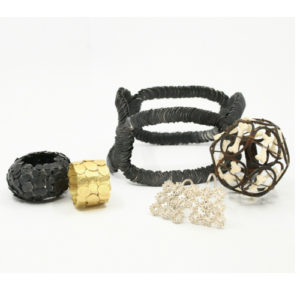
Jewelry by: VERONIKA FABIAN
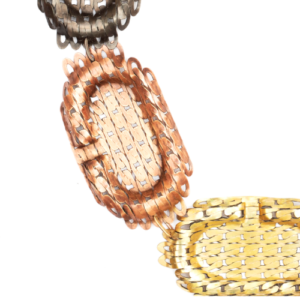
Jewelry by: VOLKER ATROPS
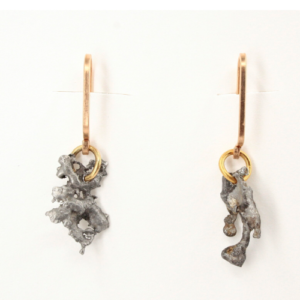
Ilona Schwippel and her partner, Christian.
![]()
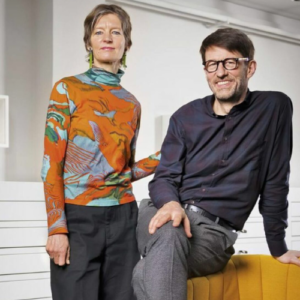
Transcript
Gallerists have a unique position in the jewelry world as the connectors between artist and wearer—and Ilona Schwippel holds sacred this responsibility. As co-owner of jewelry gallery Viceversa in Lausanne, Switzerland, she is always looking for the pieces that resonate with her and her clients. She joined the Jewelry Journey Podcast to talk about why jewelry carries the memories of its previous owners; why jewelry gives artists more freedom than any other medium; and how giving context to a piece can change a customer’s perception of it—for better or worse. Read the episode transcript here.
Sharon: Hello, everyone. Welcome to the Jewelry Journey Podcast. This is the first part of a two-part episode. Please make sure you subscribe so you can hear part two as soon as it’s released later this week.
Many of you know that I went on Art Jewelry Forum’s trip to Switzerland to find Swiss jewelers that I didn’t know about. Art Jewelry Forum has an international trip every year, and they’re usually very interesting and very good. There I met Ilona Schwippel and her partner, Christian, who are owners of the gallery Viceversa. The gallery has a mix of up-and-comers as well as those who are familiar names. They’re located in the center of Lausanne. It’s a great place to be located because there’s a lot of foot traffic. People must stop in the store never having heard of it, but they are attracted by the windows. I was really taken with the name of the gallery, which is Viceversa, and thought about what it could mean. Since I couldn’t come up with anything on my own, I’ll let Ilona tell you. Ilona, welcome to the podcast.
Ilona: Hi Sharon. Thank you so much for this wonderful invitation.
Sharon: I’m glad you’re here.
Ilona: Actually, to explain the name, I have to talk about the story of Viceversa gallery. Christian Balmer —actually my husband; we’re married—opened a small gallery in 1991. A couple of years later, in 1998, with a colleague, they opened a new store, a new gallery. All of a sudden, there existed these two stores. It was like vice versa—one of them in the other store. That’s why when I’m talking about organizing and summing up this whole project, each of them came up with the word, vice versa and vice versa. So, they stuck to the name and selected it for the new gallery.
I came to Lausanne. We had met a couple of years before. At the time, I was still living in Lisbon. I’m a jewelry maker, and I had an internship, a practice, in Tel Aviv with an Israeli jewelry maker. During a show we had in Basel, Christian came as a visitor, and that’s how we met. It was a professional meeting.
Sharon: I was surprised because in reading about it, the name of the gallery had been around for a long time, it seemed.
Ilona: Yes, this year in November, in three weeks, we will celebrate 25 years of the galleries.
Sharon: Wow! It’s a hallmark. There are not many galleries that can say that. So, you’re married. My next question was why did you and Christian decide to have the gallery together, your own art gallery? You are married. You studied in Lisbon?
Ilona: I did an apprenticeship. I started doing an apprenticeship in jewelry making with a master, as you can do in many places. It’s quite usual to do that. Also, in order to find my own way of working, of thinking, of seeing things, I wanted to go abroad and feel the edges, feel the limits, and go beyond them. I had chosen Lisbon to experience this new context and to work there as an independent jewelry maker and designer. Since there is a very good school, I had the chance to participate in several workshops. It was my first contact with contemporary jewelry at the time.
Once in a while, I had questions that I didn’t find the answers to. I was seeking dialogues. So, I saw in a magazine at the time an article about this Israeli jewelry maker, and I thought, “Well, these are the forms, the look he puts on jewelry and on the wearer.” I think it really taught me, even at that point. So, I got in contact with her. I did an internship with her for three months, and that’s when we prepared the exhibition. At the exhibition, they were paying her a visit.
Sharon: You said that was your first contact with contemporary jewelry, in Lisbon?
Ilona: Yeah, I would say so. I had a wonderful master to follow through my apprenticeship, very extraordinary pieces, only one-of-a-kind pieces. That was something completely spectacular and very generous. He is a wonderful person. I’m very grateful that I could work with him, that I could have this first contact with jewelry with him. But if you have such a strong master, it’s really important to find your own way of working, your own way of seeking, of questioning, to have your critical eye on your own work. It was important to me to go abroad and do something completely different, to jump into the cold water and to find my own task.
Sharon: Were you able to do that in going abroad?
Ilona: I guess so, yes. It was great. It was a wonderful time there, very special. It was the first time I was really imposing some limits or—how do you say—subjects and restrictions. I gave myself restrictions in my work to make it go to the essence of what I wanted to do, where I wanted to go while working, just getting step-by-step closer to what I really seek.
Sharon: Up until that time, did you look at antique jewelry, vintage jewelry, other kinds of jewelry?
Ilona: Yes, I did. I always thought it was really beautiful and touching, the care that was put into these incredible pieces and what they represented, not only for the person who wore it, but also for the people who saw it. It has this important symbolism, this important status, and this non-verbal communication to really tell things about yourself and your status with pieces.
I needed this freedom that jewelry can offer, or that the material and the body can offer, to seek something else. I thought it was beautiful and I appreciated it, but it was not really an inspiration. For example, my master, when I did the apprenticeship, was working with incredible stones. It was very spectacular and colorful and joyful. To find my own way, and so I didn’t continue doing his work, I restricted myself by saying, “Don’t do pieces with stones. No stones.” That was maybe my first restriction.
Sharon: So, you didn’t do anything with stones until now.
Ilona: Yes.
Sharon: Did he use a lot of stones?
Ilona: Yeah, incredible. It’s very colorful, exceptional stones. Like many stone cutters, like the most knowing ones, the most famous ones, they have with the most exceptional stones, first of all. His studio designed the very best stones, and then they went to other places. So, it was really old and very big.
Sharon: Do you show the stuff your master does in the gallery?
Ilona: Quite a while ago, we did a group exhibition and he was invited. He participated, and that was really nice.
Sharon: Do you have different kinds of exhibitions of jewelers that you didn’t know before you picked them for your exhibitions?
Ilona: Yeah. For example, for the 25th anniversary, we worked with five great artists of 25 years, five very exceptional artists. The first man is Sigurd Bronger, a Norwegian artist, who had a solo show at the in Munich in the spring of 2024. So, they were very excited that he’s in the show. He’s from Norway. Katrin Feulner from Germany, and a Korean artist, Ji Hee Hong, also someone we never worked with before.
Eric Loubser from South Africa is the only we’ve already worked with. In 2021, we organized a big double exhibition which was called Tangible Dialogue with 11 Japanese artists that are based in Japan. These 11 artists showed their work here in Lausanne. That was a wonderful, great exhibition. It was a very nice event. The year after, 11 Swiss jewelry artists were showing their work in Tokyo. So, we had this double exhibition, and that was where we had the first contact with Shinji Nakaba. So, we’re really happy that he’s in the show for 25 years now.
Sharon: Wow! What were your trepidations? Were you nervous about having people in the show that you hadn’t worked with before?
Ilona: That’s a very good question. It’s very exciting. We are really looking forward to setting up the show and organizing everything and then celebrating. Once you get the parcel and open it, it’s always this incredible discovery. If it’s the first time you’ve worked with somebody and you discover the piece, if it’s the first time you’ve touched it, you can see that it’s round and see the volume and the details, it’s always a very special moment. It’s very emotional.
Sharon: How do you find all these people?
Ilona: Schmuck in Munich. We’re so lucky, and I guess the whole jewelry world is so lucky, that it exists with such great enthusiasm and this great dynamic, and also this incredible quality. I think this is something very exceptional. Then we go see exhibitions abroad, like in Paris, to have a look at jewelry. This is always interesting to see artists that are not yet known, to discover talents. I think also that AJF is a great platform to discover, to get information. It is really fantastic. Yeah, there are different channels.
Sharon: Do you have to go out to find these people or do they come to you?
Ilona: Both.
Sharon: Both? How do they come to you, with photos?
Ilona: Either they come directly to the gallery or they email us, or we know each other. They talk to us in Munich. Different ways exist, but I would say mostly it’s by email because people are informed. They inform themselves; they read. Also, there’s Instagram. It’s the same, either Instagram or email.
Sharon: That’s interesting, Instagram. Did you have a slowdown during Covid? I don’t know how it was in Switzerland.
Ilona: Yes, we did. We had a shutdown twice. This was the first lockdown we had. We had moved into our new place and had our first exhibition to celebrate this new gallery, which was the exhibition with these 11 wonderful Japanese artists. Then a couple of weeks together, boom, it was a lockdown. It was really hard. Even though we couldn’t open the gallery, we came every day. Of course, there was a lot of email and things to do, but I had the impression that without the clients, without these people passionate about art jewelry, that the pieces were all orphans. They needed us to look at them and touch them, to manipulate them. That was a very strong feeling. So, we came and started to organize the next exhibition. It was also to have the artists keep believing in it. Yeah, it was really terrible.
Sharon: How do you decide which exhibitions you’re going to have?
Ilona: What is really important for us is always the fact that we have to be touched by the work. It’s a great pleasure for us to show this work, and we really look forward to proudly presenting it to our public. I think it’s a very important point to believe in the work and to be able to transmit that to the visitors. I see our work as governance. I see it as the link between the artist and the person that will fall in love with the piece. Without us, they might not meet. We can also give peace. We talk about the pieces; we talk about the artists. We give people peace to read the piece, to find details, to read the details of the piece and to see it in a certain context that was wanted by the artist. I think it’s important to have this emotional contact.
Sharon: We didn’t have that much time to spend at your gallery. Do you think there are pieces that people like, but you tell them what the artist meant, and they look at it in a totally different way? Somebody once said they have to meet the artist first, which I don’t believe in, but they said that. I have to like the piece. That’s important to me, but if somebody explained what they were trying to say, that might be different.
Ilona: I guess so. Every artwork, if you have the title or you see it in a certain context, like an exhibition with a theme or a subject, then you look differently at the piece. You read it differently. I think it can change the perception in both ways. It can make you more open towards the piece. It can also repulse you, because maybe it’s a story or a context that is not what you feel comfortable with. So, both ways exist.
Sharon: We will have photos posted on the website. Please head to TheJewelryJourney.com to check them out.

